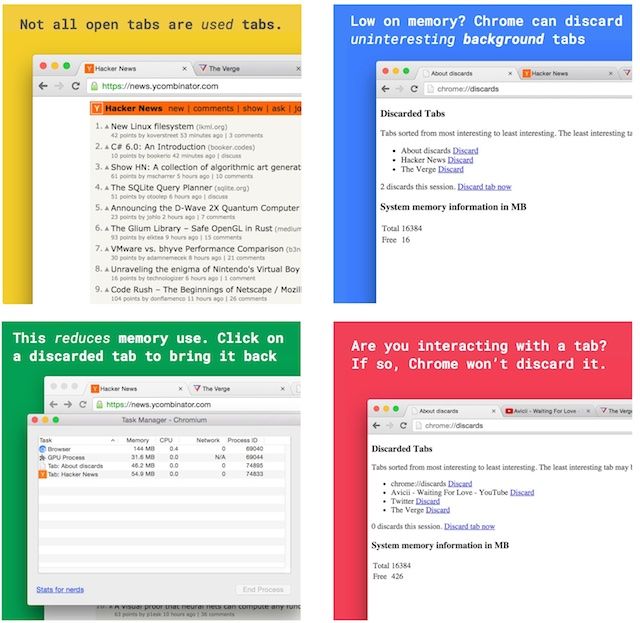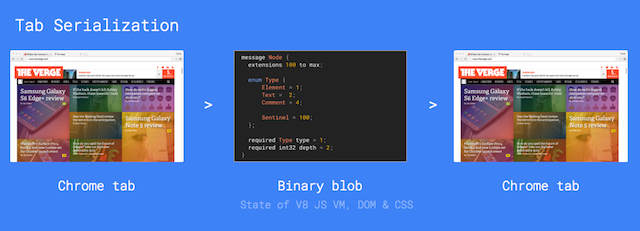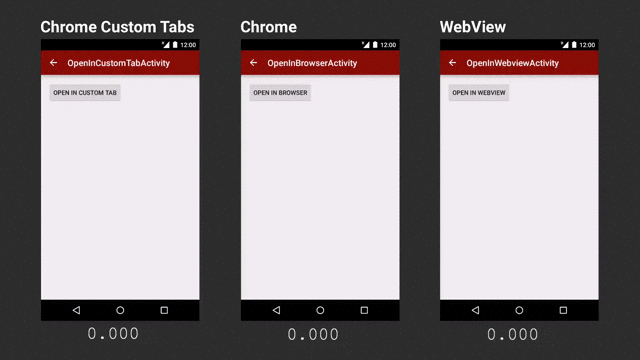Google Chrome is great and feature-packed, but Google Chrome is just so slow and annoying. Right? We've all complained about Chrome and Google is finally listening. The Internet giant is rolling out major changes to the browser that fix memory problems in the latest stable version, and actively discards unused tabs in the latest unstable version.
Apart from the memory problems, Chrome is fixing battery issues by auto-pausing Flash content. Also, a browser restart will load last opened tabs in the order you viewed them in, and stop loading too many of them. Finally, the Android Chrome browser also gets an update that brings Custom Tabs, which let third-party apps load a link in Chrome faster.
Memory, All Alone in the Moonlight
At this point, Chrome's RAM issues are well documented. The company itself says that for every open tab in the background takes around 50MB for the renderer process. So even with 10 open tabs, you are using at least 450MB of memory.
In the new Chrome 45, Google detects when a webpage isn't busy with some task and performs "garbage collection"—a process that eliminates junk on the page and frees up much-needed memory.
Google claims this reduces memory usage by 10% on average, but more on some other sites. Gmail, for instance, reduces memory up to 25%. This update is part of the latest stable Chrome build, v45, and available immediately. It should come as good news to many users.
Apart from this, as we mentioned a few days ago, Chrome 45 is getting aggressive against Flash, which has proven to be a major battery drain. The new browser will also reload tabs after a reboot in the last order you opened them in. In fact, it's smart enough not to load all tabs at the same time, and will leave a few unloaded until you actually go to the tab and activate it.
How to Get This Update
If you are an existing Chrome user, go to Menu > Help and About > About Google Chrome and it will give you an option to update, in case it hasn't automatically updated.
If you aren't an existing Chrome user, download Google Chrome 45.
But the Big News is in Chrome 46!
The more interesting news, however, comes from the upcoming Chrome 46, which is currently part of the experimental Google Chrome Canary build. Google developer Addy Osmani posted that the team is working on "Tab Discarding"—the same approach as what The Great Suspender extension does.
This new feature figures out which tabs you are looking at and which tabs you aren't really using any more. Noticing an inactive tab, Chrome will "kill" this tab without removing the visual tab from your tab bar itself. If you click on it again, you can reload the tab. Simple enough?
Now, if you're worried that this means Chrome will start killing tabs you like to keep open for a long time, like your Gmail, then relax. Google has declared the order in which it discards tabs:
- Internal pages like new tab page, bookmarks, etc.
- Tabs selected a long time ago
- Tabs selected recently
- Apps running in a window
- Pinned tabs
- The selected tab
So if you pin tabs you access frequently, you have nothing to worry about, unless your memory starts running drastically low.
How to Enable Tab Discarding in Chrome
As mentioned, this feature is part of the Chrome developer build, so you'll need to download Chrome Canary and run it if you want to try it now.
In your address bar, type "chrome://flags/#enable-tab-discarding" without the quotes and hit Enter. Click "Enable" under the entry for "Enable Tab Discarding".
Scroll to the bottom of the page and click "Relaunch Now" to reboot Chrome.
"A new page called 'chrome://discards' (without the quotes) lets you list what tabs are currently open and we try to share some insight into how interesting (we think) they are to you, from most to least," Google writes.
The Future: Tab Serializing
Google also shared that it is working on something called Tab Serializing for future updates. This tech is kind of like an improved version of Tab Discarding.
In Tab Serializing, Chrome will convert an open tab's contents into binary, thus saving your current state of browsing that tab. It can then discard the tab in the same way that Tab Discarding works. However, when you later go to reload that tab, you are transported back to the state you were in last; you don't have to start from scratch in that page.
Meanwhile, On Android
Tab Discarding is already done on Google Android, so the v45 update for the mobile version doesn't bring that. However, Android Police highlights one new noteworthy feature: Custom Tabs.
Custom Tabs aren't something that you, as a user, need to do anything with. But it will help how you use the phone. This feature gives third-party apps access to opening a link in Chrome, but doing it much faster than opening the Chrome browser and a tab in it. Instead, a Custom Tab lets that app open a lightweight Chrome tab with the link.
Our tests showed Chrome is the fastest browser on Android, so this news is welcome since it means you get the fastest browser without the bloat.
How to Get Chrome 45 on Android
You can go to the Play Store and download Google Chrome for Android. Existing users can update the app from the same link.
If you can't see the updated Chrome 45 on the Play Store, you can download the APK directly. This will require you to manually install the app on Android. If you aren't comfortable doing that, we would advise waiting a few days for the official update on the Play Store.
Are You Pleased With Chrome's Changes?
The news of Chrome addressing its memory issues is the best thing I have read this week. It's my biggest gripe with the browser and to see not just one but two technologies ready to fight it out in the near future, and another in the pipeline, is great news.
What about you? Are you happy Google is finally making progress on this, or would you like to take a wait-and-watch approach?
Image Credit: geralt / Pixabay





